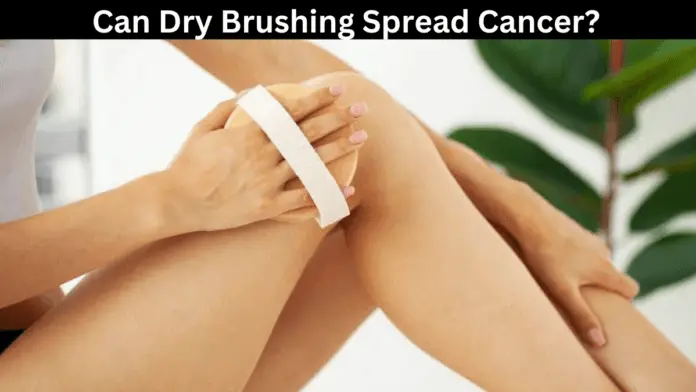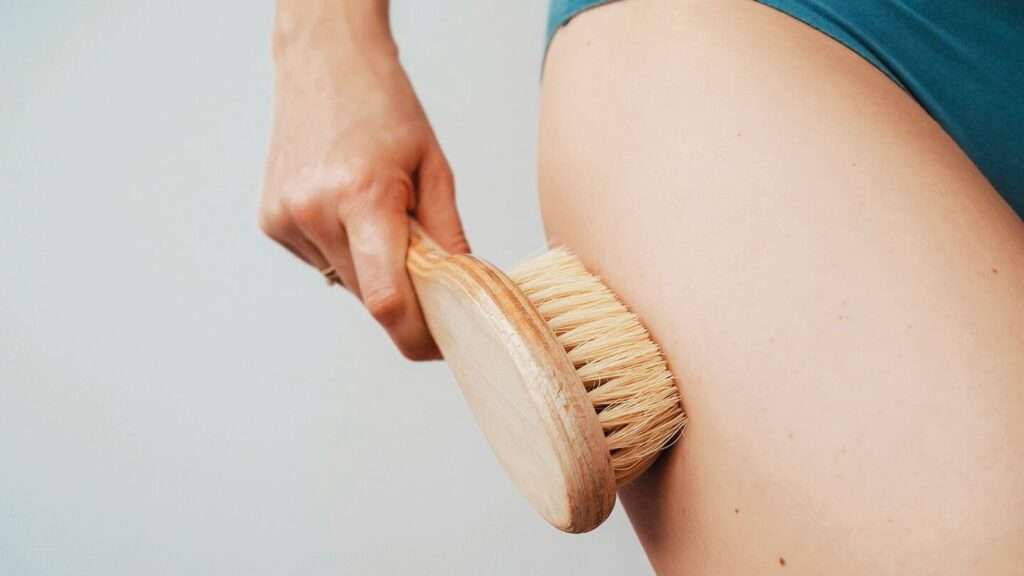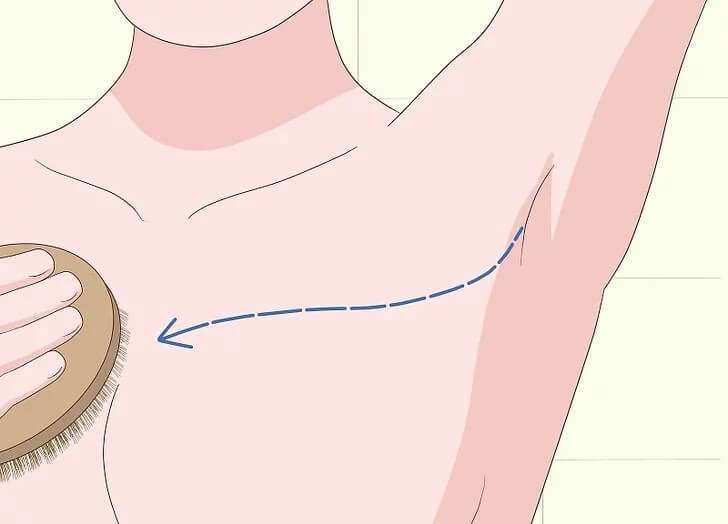
Dry brushing is a popular beauty and wellness practice that has been around for centuries. It involves using a natural-bristled brush to gently massage the skin in circular motions. This helps to exfoliate the skin, improve circulation, and reduce stress. But can dry brushing spread cancer?
The answer is no – dry brushing does not spread cancer. In fact, it may even help reduce your risk of developing certain types of cancer. Studies have shown that dry brushing can help improve lymphatic drainage, which is important for keeping your body healthy and free from toxins. However, it’s important to be mindful of how much pressure you use when dry brushing, as too much pressure can cause irritation or damage to the skin.
What Is Dry Brushing?

Dry brushing is an ancient Ayurvedic practice that has been used for centuries to promote physical and mental health. The process involves using a natural-bristled brush with long strokes in a circular motion on the skin while it’s still dry (hence the name). This helps to remove dead skin cells, stimulate circulation, and reduce stress levels. It’s also believed to help detoxify the body by improving lymphatic drainage and aiding digestion.
Does Dry Brushing Reduce Cancer Risk?
There is no scientific evidence that dry brushing reduces cancer risk directly. However, some studies suggest that it may have indirect benefits when it comes to reducing cancer risk. For example, one study found that regular dry brushing was associated with lower levels of cortisol (a hormone linked to stress) in women with breast cancer. Another study found that regular dry brushing was associated with improved immune function in women undergoing chemotherapy for breast cancer.
Dry Brushing Breast Cancer

There is no direct evidence that suggests dry brushing can prevent or treat breast cancer specifically; however, there are some potential indirect benefits for those undergoing treatment for breast cancer or those who are at high risk for developing it:
- Regular dry brushing may reduce stress levels by stimulating nerve endings in the skin; this could potentially help reduce cortisol levels which are linked to higher rates of breast cancer recurrence and mortality rates among women with breast cancer (1).
- Regular dry brushing may also improve immune function by stimulating circulation and lymphatic drainage; this could potentially help reduce inflammation which has been linked to higher rates of breast cancer recurrence (2).
- Finally, regular dry brushing may help remove toxins from the body; this could potentially help reduce exposure to carcinogens which are known to increase the risk of developing certain types of cancers including breast cancer (3).
Can Dry Brushing Spread Cancer?
There is no scientific evidence that suggests that dry brushing can spread cancer. In fact, there is some evidence suggesting that regular dry brushing may actually reduce cancer risk by improving circulation in the body. However, if you’re undergoing treatment for cancer, it’s best to consult with a doctor before trying any new practices like this one. Additionally, if you’re experiencing any symptoms related to cancer such as pain, swelling, redness, or general irritation —dry brushing should be avoided until these symptoms subside.
Benefits of Dry Brushing
There are many potential benefits associated with dry brushing, including:
- Improved circulation: Dry brushing helps stimulate circulation by increasing blood flow throughout the body. This can help reduce inflammation and improve overall health.
- Exfoliation: Regularly exfoliating your skin helps remove dead cells from the surface of your skin and encourages new cell growth. This can help keep your complexion looking bright and healthy!
- Stress relief: Dry brushing is known to be calming and relaxing due to its gentle massage-like effect on the body. It can help reduce stress levels and promote relaxation.
- Detoxification: As mentioned above, dry brushing helps improve lymphatic drainage which aids in detoxifying the body by removing toxins from our system more efficiently than usual. Read: Best Facial for Sensitive Skin
- Cellulite reduction: Many people believe that regular dry brushing can help reduce cellulite by breaking down fat deposits under the skin’s surface over time. While there isn’t scientific evidence proving this claim yet, some people swear by it!
Does Dry Brushing Have Any Side Effects?
Although generally considered safe when performed correctly and gently, there are some potential side effects associated with dry brushing including:
- Skin irritation: If you use too much pressure while performing the technique then you may experience redness and irritation on your skin. This can usually be avoided by using gentle strokes and avoiding areas where you have any open wounds or other conditions such as eczema or psoriasis.
- Allergic reactions: Some people may experience an allergic reaction if they use brushes made from materials such as boar hair or sisal fibers which they are allergic to. If this happens then switch to a brush made from synthetic materials instead such as nylon bristles.
- Infections: If you don’t properly clean and store your brush after each use then bacteria can build up on it which could lead to infections if used again without being cleaned first. To avoid this make sure you clean your brush regularly with warm soapy water and allow it to air-dry before storing it away in a cool place away from moisture and direct sunlight.
- Spread of warts: Warts are caused by viruses that can easily spread through contact with infected surfaces such as brushes used for dry brushing so make sure you always use a new brush each time you perform the technique if possible. Read: Are Plantar Warts Contagious?
- Skin damage: If you use too much pressure while performing the technique then this could lead to bruising or other forms of skin damage so always take care not to press too hard against your skin while performing the technique and stop immediately if any pain occurs during the process.
How To Perform Dry Brushing Safely
- Start at your feet: Begin by standing up straight with one foot placed firmly on the ground in front of you while holding onto something stable for balance (such as a wall). Then take your brush in one hand and begin making small circular motions starting at your feet and working up towards your ankles before moving onto other areas such as legs, arms, chest, back, etc. Make sure not to press too hard against your skin – just enough pressure so that you feel like it’s lightly massaging rather than scraping against it.
- Use gentle strokes: When performing each stroke try not to press down too hard – just enough pressure so that it’s lightly massaging rather than scraping against it. Also, remember not to rush through each stroke – take time between each one so that all areas get equal attention.
- Move towards the heart: When working on different parts of your body always move towards your heart rather than away from it. This will help encourage better circulation throughout your body.
- Cleanse afterward: After finishing up make sure you rinse off any excess oils left behind by using warm water (not hot) followed by mild soap. Then pat yourself down with a towel until completely dried off before applying moisturizer afterward if desired.
Final Thoughts
In conclusion, although there is no scientific evidence suggesting that dry brushing can spread cancer cells throughout our bodies, we should still be aware of potential risks associated with this practice such as irritation, allergic reactions, infections, the spread of warts, etc . Therefore we recommend taking extra caution when performing this technique especially if we have sensitive skins prone to irritations, etc. Additionally, always make sure we clean our brushes regularly after each use in order for them to remain hygienic for future uses. Finally, remember never to rush through each stroke but instead take time between them so all areas get equal attention whilst ensuring not to press down too hard against our skin during each stroke either otherwise this could lead us to experiencing unwanted side effects later down line!
FAQ
Who should avoid dry brushing?
Dry brushing is not recommended for people with sensitive skin, open wounds, or rashes.
What is dry brushing for cancer?
Dry brushing for cancer is a form of massage therapy that can help reduce swelling and improve lymphatic drainage.
Are there any risks from dry brushing?
There are some risks associated with dry brushing, such as irritation and infection.
Is it OK to dry brush everyday?
It is generally not recommended to dry brush everyday; once or twice per week should be sufficient.
Do dermatologists recommend dry brushing?
Some dermatologists may recommend dry brushing as part of a skin care routine, but it is best to consult your doctor before beginning any new regimen.
Do I have to shower after dry brushing?
After dry brushing, it is important to shower in order to rinse away any dead skin cells and toxins that were removed during the process.
Read: How to Repair Laser Damaged Skin












